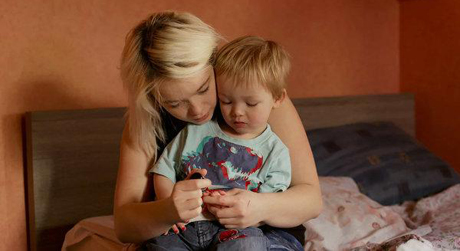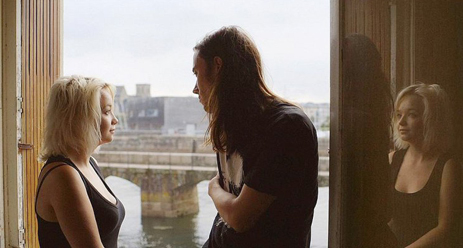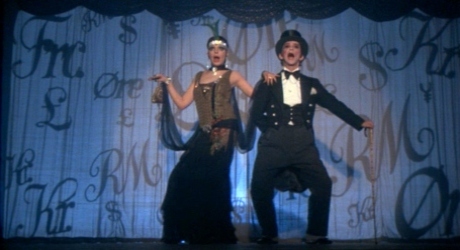
To give—what a startling idea in this era of acquisitive capitalism. But every aspect of Valérie Massadian’s filmmaking is a study in reciprocity. It’s in her patient camerawork, which takes in the physical gestures that often replace words. It’s in her keen sensitivity to the textures and details of domestic spaces: a rickety window frame, peeling wallpaper, sunlight gracing a cheek. And it’s in the unromantic way she calls attention to people whose realities have been rendered invisible, beautifully capturing their ordinariness, uninterested in the rest.
Massadian uses documentary techniques to tell fictional, almost fairy tale stories that grow from her collaborations. Her two astonishing features depict girls and young women at what she’s described as “transition ages, when humans don’t really have a place in the world”: Nana (2011) is a portrait of a four-year-old girl, while Milla (2017) honours a teenage mother.
Milla follows the titular seventeen-year-old played by Séverine Jonckeere, a non-actor (“I call them people,” Massadian says) the filmmaker met while casting for young mothers in some of the poorer areas of northern France. Actor Luc Chessel plays Milla’s boyfriend Leo. Together, the young lovers try to start a life, a fraught yet bliss-filled endeavour which unfolds through ellipses and apparitions. They squat a house by the English Channel, and when Milla falls pregnant Leo gets a job on a fishing boat. One night he doesn’t come home, leaving Milla to raise her child (played by Jonckeere’s son Ethan) on her own; she finds work in a cheap hotel, where Massadian appears in the role of an older maid and friend.
“If you come into someone’s life, you can’t just come and take and leave. I spend a lot of time with the people in my films and they’re family. It’s important because they’re people, they’re not puppets for your art.”
I spoke with Massadian about what drives her filmmaking: respect, resilience, and the enduring significance of poetry and dreams, influenced by her Armenian background. Underlying these ideals is a persistent rage against the violence of capitalism, which is kept in check by the director’s fierce concern for others. The resulting aesthetic centres generosity and consideration—a radical move, brimming with hope.
I was belatedly introduced to your cinemathanks to the Queensland Film Festival, where Milla and Nana ran in a program dedicated to the aesthetics of care. How central is this idea of ‘care’ to you as a filmmaker, and what power do you think it has?
Oh, it’s the main issue for me. I don’t think it’s a matter of power, I think it’s a matter of responsibility. A lot of films that want to denounce something, actually the gesture they make is the same: it carries the same violence as what they’re supposed to be denouncing. They don’t even realise. And it’s because they use people—and I use the word “use”—as objects or ideas. It’s not only in films, it’s in politics, everything. It’s unbearable.
That’s why I talk about responsibility. I remember when I ended Nana. I finished the edit—it was three in the morning and I needed to get out so I went into the street and walked, I couldn’t feel the ground, and I started talking to myself. The things I was saying—I was very emotional, crying—were “I didn’t betray her,” “I didn’t betray myself,” “I didn’t betray us.”
If you come into someone’s life, you can’t just come and take and leave. I spend a lot of time with [the people in my films] and they’re family. Kelyna [Lecomte, the lead of Nana], she’s eleven [now] and we still talk. It’s important because they’re people, they’re not puppets for your art. This disgusts me.
You’ve worked closely with Pedro Costa, whose approach is similar to yours: the shoots are collaborative, the actors become co-authors. You also don’t really work with a script.
In the filming, my work is to invent games—that’s how I say it, like with children. We play at the film, we don’t make a film. She doesn’t act, she plays with whatever objects or actions I give her. I don’t give emotional or psychological direction. And sometimes it really pisses them off, because they’re like, “What the fuck do you want me to do?”

What about Milla? How was it working with Séverine, filming her life?
I think it’s not her life we’re seeing, even during the last part with her kid, because the reality of her situation is more massive than it is in the film.
It’s more about the way they talk, their rhythms, how they move their body in space. It’s them—it’s their essence, it’s their animality—but it’s not their life. They become characters through editing. For example: the scene when [Milla and Leo] are washing the sheet in the bathtub. The reality of when we’re filming is she’s in a super bad mood—she’s a pain in the ass because she’s a pain in the ass, I can only work with pain in the asses because I am one myself—and Luc is trying desperately to cheer her up. But in the film it becomes something else, because it comes at this moment when she’s pregnant and you feel something’s not right in their relationship. So that’s my work as a filmmaker.
My decision—which is not something I’m conscious of, I only understand after—is to give her keys to see. Something simple she said to me was, “Now my house is clean, it’s not a mess anymore.” Because, you know, she was twenty and Ethan was four and it was a trash pile.Because she’s young and had no time or energy, and she hated doing it and—
She’s a single mum, and that’s what life’s like.
Exactly, and I shot [some footage early on of the house like] that. And it affected her, a lot. She was really pissed off at me. I said, “But I’m not going to show it like this. And even if I do, I’ll never show it as something negative.” In the end, it’s not in the film because I didn’t need it. The choice was to focus on how she grows with the kid: even if Ethan is screaming, she’s always super patient in the film. And it was a choice, voilà—that’s my way of telling her that I love her. A film has to give….
So it’s there, but what I try to do is [convey it] through poetry; it gives the viewer space. The meanness of the world—you don’t see it, it’s hors champ, but it’s there all the time, to feel and think. As much as I include the people in the film, I also want to include the people watching. I want to give space for them to think a little. [Laughs]
I’m really very angry as a person, as a woman, and sometimes I don’t know where to put that anger. When I make a film, I turn it into love.
In the text you contributed to the Cinéma du réel 40th anniversary publication, you wrote, in answer to the question, “What is real?”: “Real is when at three years old you ask your mother why that woman and that man are sleeping on the ground, and when you’re 20, you’ve got to find the words to explain to your son why this woman and this man are sleeping on the ground.” I wondered if the film is an attempt to explain how a woman like Milla might end up in a situation like this, and how much of our respect she deserves.
In the text I wrote, I’m so angry. I’m really very angry as a person, as a woman, and sometimes I don’t know where to put that anger. When I make a film, I turn it into love.
I try to give space and offer an image of this fragility. It’s the thing you said about respect, because when you get in a hotel with her [Milla] and she doesn’t know how to fold a fucking thing—in a lot of films you would laugh at her, you would mock her. Here, it’s the opposite, or I hope it is. This fragility, this thing that in society is judged and crushed, you want to hug and you want to protect. If I put that in your brain through one sequence then I won already, you know?
I’d like to go back to what you said before about poetry. There’s a scene where Leo stands in the bedroom and delivers straight to camera a poetic monologue, which reads like a love letter. As a viewer, this scene jolts us into a woozy, fantastical space.
Poetry has been [relegated to] this place of something irrelevant. Nobody reads poetry but it’s everywhere, it’s all around me. And the thing that keeps me alive is these little moments I see in daily interactions with people, of gestures, of caring mostly, that save me. We’re not completely dead yet. So to have it be in films, for me it’s like [deep breath in]a shot of oxygen.

Then, there’s also the fact that I’m half-French and half-Armenian. I was raised by my Armenian grandparents—we lived with them because my parents didn’t have much money—and their understanding of dreams is very different from that of the Western world. For Armenians, it’s a parallel life: it’s not something that’s outside, it’s completely the same. The frontier between reality and dreams is very porous, you move between. When you watch [the films of Sergei] Parajanov, for example, it’s there, always. When I tell a story, I’ll include something I dreamt. When Milla’s in her house sewing alone and then it [cuts] to the hotel and there’s the band, and then you come back and she’s in bed—that’s how you know it’s a thought, a dream, a whatever-you-want-to-call-it… it’s not real but it is. What’s real, anyway?
Perhaps a nice example is the way Milla laughs.
When she laughs, it’s like a glass that you throw on the floor. It can be super annoying, and at the same time it carries this sadness and the screams of every fucking woman on the planet. It’s this resistance through laughter that, for me, is so heart-breaking.
And yet it lifts the situation, injects levity, offers reassurance.
It’s all about resilience…. All the women in Milla—Milla and Séverine, me and Isabelle [Massadian’s character], the woman who has the fruit stand—they’re all the same woman. And I play with that. For example, the second time you see the vacuum cleaner, you think it’s going to be Séverine but no, it’s me [Isabelle]. You know nothing about this woman in the hotel but you know everything, because they’re the same. You can invent: she has a kid, and you can tell from the story that she got out; somehow, she escaped the fatal destiny. Even though she’s a maid, all the objects around her are more refined. She has other worlds and she managed.
Your films show deep respect for older women like Isabelle, and also for little kids.
I have had the most philosophical conversations with four-year-old kids. For real! I learn from kids and from really old people—the middle is bullshit. [Laughs] We’re lost.
Kids are discovering the world so they’re hungry, they observe everything; they’re like this sponge and everything gets in. And the way humans have built society is that you have to close that sponge because otherwise you die, you’d be crying and screaming in the street.
Two days ago, I saw a four-year-old girl in the street and she’s got her skirt hiked up and she’s scratching her ass like that so you can see her underwear—and I just thought it was so wonderful. [Laughs] I want to scratch my ass like that, and I can’t.
This interview has been edited and condensed for length and clarity.





